Your search for 'nipple'
returned
333 results.

|
English Durs Egg - London right Percussion Conversion Lock, by L&R
Durs Egg - London right Percussion Conversion Lock Best quality London made flint locks were often converted to percussion, during the 1825 - 1840 transition period. This nice percussion lock has the plate style of an earlier flint lock, with a notch for a 7/16" powder drum and nipple. A fly detent prevents the sear from snagging the half-cock n
|

|
1830 era small rifle, or pistol percussion lock , right hand, by L&R
1780 era rifle or pistol percussion lock, right hand, by L&R New competition for the small Siler lock, L&R’s new flat faced lock is for use on American, English, or French longrifles or pistols and would be typical of a lock from the he 1760-1800 era that was converted circa 1830 to percussion. This lock is made to fit the small Siler lock morti
|

|
Classic conversion , right hand, percussion lock, by L&R
L&R's new Classic cap lock is a true conversion. The pan is still evident on the lock plate. The pan molding and flash fence have been retained, and the pan groove has been enlarged to accept a 1/2" diameter powder drum and nipple. L&R's new conversion lock is made to be a tight fit in the Siler lock mortise, and is a tiny bit larger, with a longer
|

|
Mule Ear or Sideslapper right hand, percussion lock, by L&R
The L&R Mule Ear or Sideslapper percussion lock design allows the percussion nipple to be mounted directly into the barrel. Pull the hammer outboard to cock the lock. Unlike some mule ear locks this lock has both a half cock and full cock position on the tumbler. The lock plate is 5.1" long by 0.94" tall. The tumbler is fitted with a fly detent to
|

|
English Durs Egg - London left Percussion Conversion Lock, by L&R
Durs Egg - London left Percussion Conversion Lock Best quality London made flint locks were often converted to percussion, during the 1825 - 1840 transition period. This nice percussion lock has the plate style of an earlier flint lock, with a notch for a 1/2" powder drum and nipple. A fly detent prevents the sear from snagging the half-cock not
|
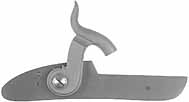
|
English Bar Lock right Percussion Lock, with early flat hammer, by L&R
English Bar right Percussion Lock, with early flat hammer The English “bar" lock is so-called because it uses a “drip bar" soldered to the barrel, instead of wood above the lock plate. This improvement eliminates wood in this critical area ahead of the nipple, where constant over-spray might char it. Most better London & Birmingham makers used
|
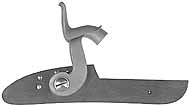
|
English Bar Lock right Percussion Lock, with Express hammer, by L&R
English Bar right Percussion Lock, with Express hammer The English “bar" lock is so-called because it uses a “drip bar" soldered to the barrel, instead of wood above the lock plate. This improvement eliminates wood in this critical area ahead of the nipple, where constant over-spray might char it. Most better London & Birmingham makers used “bar
|
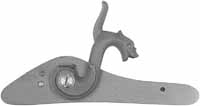
|
Schuetzen right hand, percussion lock, by L&R
A classic late Germanic style percussion lock, with smooth curves all around the lock plate. The front of the plate is long enough to allow using two lock bolts, although one lock bolt is more typical in this late percussion era. The hammer has a long throw to reach the nipple on nearly any hooked or solid patent breech. The highly styled gargoyle
|
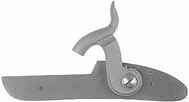
|
English Bar Lock left Percussion Lock, with early flat hammer, by L&R
English Bar left Percussion Lock, with early flat hammer The English “bar” lock is so-called because it uses a “drip bar” soldered to the barrel, instead of wood above the lock plate. This improvement eliminates wood in this critical area ahead of the nipple, where constant over-spray might char it. Most better London & Birmingham makers used “b
|
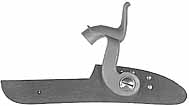
|
English Bar Lock left Percussion Lock, with Express hammer, by L&R
English Bar Lock left Percussion Lock, with Express hammer The English “bar” lock is so-called because it uses a “drip bar” soldered to the barrel, instead of wood above the lock plate. This improvement eliminates wood in this critical area ahead of the nipple, where constant over-spray might char it. Most better London & Birmingham makers used
|
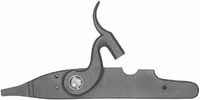
|
Bedford County right hand, percussion lock, by L&R
Studying the longrifles of Bedford County, Pennsylvania, might cause you to imagine that time nearly stopped in Bedford County, or that this region was isolated from the world. How can we explain why these men continued to make Bedford County rifles for over 120 years, much later than we might expect? How can we explain these very odd locks, with l
|
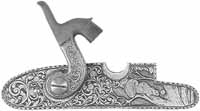
|
Ohio Squirrel Cap Lock , right hand, percussion lock, by R. E. Davis
This late percussion lock has engraving cast into the surface of the hammer and plate, decorated with ‘S’ and ‘C’ scrolls and leaves in classic style. The leaves open to a clearing at front, revealing a bushy tailed squirrel on the limbs of a tree. An example of American folk art circa 1853, from a rifle by O. B. VanDenBurgh, Findlay, Hancock Count
|
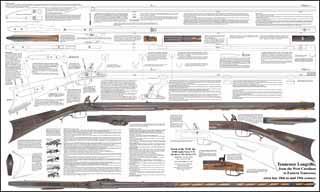
|
Plan drawing , full exact size, with tips for assembly, Tennessee Rifle
The Tennessee school of iron mounted rifles typically originate from the Western Carolinas to Eastern Tennessee. These drawings illustrate a classic iron mounted Tennessee longrifle. Plans show variations in trim, and techniques for omitting certain pieces of the furniture in "poor boy" style. Flint shown, drum and nipple percussion ignition is dis
|

|
Hawken fullstock , pre shaped stock, pre-inlet, 1" octagon, 42" barrel, L&R late English lock
Shaped and pre-inlet for, L&R right hand late English lock, L&R Hawken double set triggers, and 1" flint hooked breech, this Hawken fullstock is modeled after the early work of Jacob and Samuel Hawken, with an early square cheekpiece, not the later beavertail found on halfstocks. We strongly recommend straight grain maple for large bores. Shaped fo
|

|
Hawken fullstock , pre shaped stock, pre-inlet, 1" octagon, 42" barrel, L&R late English lock, plain maple
Shaped and pre-inlet for, L&R right hand late English lock, L&R Hawken double set triggers, and 1" flint hooked breech, this Hawken fullstock is modeled after the early work of Jacob and Samuel Hawken, with an early square cheekpiece, not the later beavertail found on halfstocks. We strongly recommend straight grain maple for large bores. Shaped fo
|

|
Hawken fullstock , pre shaped stock, pre-inlet, 1" octagon, 42" barrel, L&R late English lock, fancy maple
Shaped and pre-inlet for, L&R right hand late English lock, L&R Hawken double set triggers, and 1" flint hooked breech, this Hawken fullstock is modeled after the early work of Jacob and Samuel Hawken, with an early square cheekpiece, not the later beavertail found on halfstocks. We strongly recommend straight grain maple for large bores. Shaped fo
|

|
Hawken fullstock , pre shaped stock, pre-inlet, 1" octagon, 42" barrel, L&R late English lock, extra fancy maple
Shaped and pre-inlet for, L&R right hand late English lock, L&R Hawken double set triggers, and 1" flint hooked breech, this Hawken fullstock is modeled after the early work of Jacob and Samuel Hawken, with an early square cheekpiece, not the later beavertail found on halfstocks. We strongly recommend straight grain maple for large bores. Shaped fo
|

|
Hawken fullstock , pre shaped stock, pre-inlet, 1" octagon, 38" barrel, L&R late English lock
Shaped and pre-inlet for, L&R right hand late English lock, L&R Hawken double set triggers, and L&R 1" flint hooked breech, this Hawken fullstock is modeled after the early work of Jacob and Samuel Hawken, with an early square cheekpiece, not the later beavertail found on halfstocks. We strongly recommend straight grain maple for large bores. Shape
|

|
Stock, Hawken fullstock , left pre-inlet 1" octagon, 42" barrel, L&R late English lock, plain maple
Shaped and pre-inlet for, L&R left hand late English lock, L&R Hawken double set triggers, and L&R 1" flint hooked breech, this Hawken fullstock is modeled after the early work of Jacob and Samuel Hawken, with an early square cheekpiece, not the later beavertail found on halfstocks. We strongly recommend straight grain maple for large bores. Shaped
|